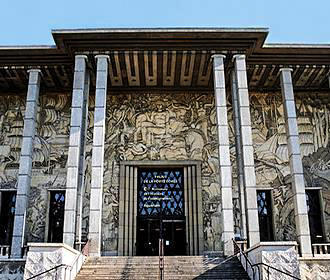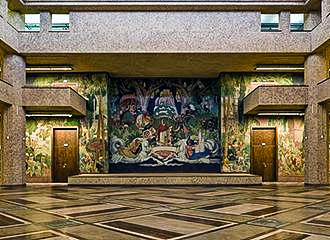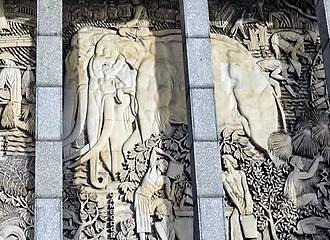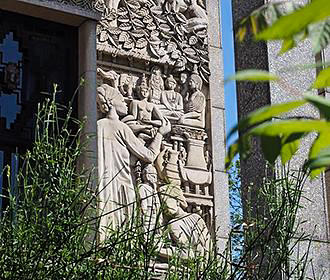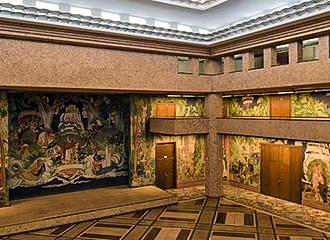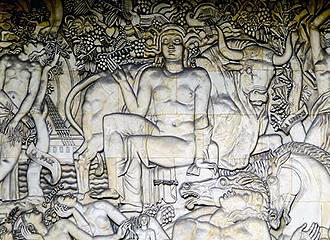Palais de la Porte Doree museum and monument in Paris
Home to the Museum of the History of Immigration in France and a tropical Aquarium, this building was first constructed for the 1931 International Exhibition and is now classed as an historical monument in Paris.
The History of the Palais de la Port Doree
The Palais de la Porte Doree translates to the Palace of the Golden Gate and was constructed for the Colonial International Exhibition in 1931 with a main purpose of being a museum dedicated to colonial conquest of the territories and its impact on the arts.
After the exhibition the palace changed its general assignments several times but the hall and reception rooms still bear witness to this past of Marshal Lyautey, who was the general curator of the exhibition, along with Paul Reynaud who was the minister of the colonies.
Up until 1935 the Palais de la Porte Doree was home to the Museum of Permanent Colonies then it changed to the Museum of France Overseas until the late 1950s, but by 1961 this exhibition venue and museum had turned into the Museum of Arts of Africa and Oceania.
In 1990 it then became known Musee National des Arts d’Afrique et d’Oceanie, yet with the opening of the Musee Quai Branly, the collections were transferred to this new museum in Paris that opened in 2006.
This meant that the only part remaining open to the public was the Palais de la Porte Doree Aquarium Tropical and the historical rooms of the ground floor.
However, a redevelopment and renovation project was put in place, and since 2007 after having become classified as a historical monument in Paris twenty years prior, a new museum opened called the Cite Nationale de l’Histoire de l’Immigration, which is a museum dedicated to the History of Immigration in France.
Building of the Palais de la Porte Doree and its Transformation
The Palais de la Porte Doree was designed by the architect Albert Laprade where he created a synthesis of Art Deco style combining French classical and Moroccan architecture that was freely inspired by the art colonies elements.
There were also numerous frescos that were produced for the inside of the palace along with bas-reliefs on the facade, which were designed in order to illustrate the colonial International Exposition in Paris in 1931.
However, as with any building, it will deteriorate over the years and a redevelopment plan along with restoration programme was put in place in the October of 2006 in order to bring the Palais de la Porte Doree back up to the required safety standards.
It also included the maintenance and restoration of the historical aspects of the building such as the impressive frescos and mosaics, yet also incorporated designing an area to accommodate the installation of the Cite Nationale de l’Histoire de l’Immigration museum.
The Palace of the Golden Gate has also undergone major improvements for access to the disabled including designing new entrances and now a hall that had been closed to the public for quite some considerable time is the central space for the new museum, and this is linked to the hall that includes the entrance, cafe and bookstore.
Yet innovations also prevail, such as the utilisation of benches that can be closed to create additional floor space in this original hall, not forgetting that the galleries overlooking this forum or hall were reopened to allow for its original brightness, plus an auditorium was added along with a library.
Even though the Palais de la Porte Doree was open during the major work undertaken between 2006 and 2011, another project was also put in place to create an entry suitable for people with reduced mobility and wheelchair users, along with ways for creating additional light into the building.
Plus the garden area was completely redesigned and replanted with a phenomenally wide variety of plants from many countries that were imported initially, whether intentional or not. For instance, it was the Polish who immigrated the horseradish plant to France, and this has all been instigated by the landscape architect and botanist, Liliana Motta, which continued into 2013.
So even though there are many modern elements to the Palais de la Porte Duree tourist attraction in Paris, there are also lots of historic features to discover, not forgetting that you can still get to visit the Tropical Aquarium and the Cite Nationale de l’Histoire de l’Immigration.
Visiting Palais de la Porte Doree historical monument in Paris
You will be pleased to know that the Palace of the Golden Gate is open on a Tuesday through to a Friday from 10am through to 5:30pm and on a Saturday and Sunday from 10am through to 7pm.
It is always closed on a Monday along with certain national French holidays, and providing you arrive a minimum of 45 minutes before closing time, you can access the Hall of Honour, the former Ballroom and the historical exhibitions completely free of charge.
The Abdelmalek Sayad Multimedia Library is open on a Tuesday to Friday from 2pm through to 5:30pm and on a Saturday from 2pm to 7pm, yet it is closed on all other days along with all national holidays plus when France has its school holidays including the entire month of August.
Access to the Palais de la Porte Doree
When it comes to getting to the Palais de la Porte Doree via public transport in Paris, you will find that it is located in the 12th Arrondissement close to the Boulevard Peripherique and the nearest Metro station is the Porte Doree stop serving line 8.
Alternatively, the bus line 46 or the Tramway via line T3a will also get you within walking distance of this popular tourist attraction, and access to the disabled is via the entrance on Rue Armand Rousseau, with a public car park also located close by.
It also close to impressive Bois de Vincennes with its tourist attractions such as the Parc Zoologique de Paris and the Cirque Phenix, yet by utilising the tram you could easily get to other places in the area such as the Pavillons de Bercy or the River Seine, so this area of the city is ideal for a family day out when you are visiting Paris.
